Burton-upon-Trent, Staffordshire
Up to 1834
Burton set up a workhouse in 1728 in a converted barn at the west side of Anderstaff Lane (now Wetmore Road). In 1776, it could house 60 inmates. In 1782, Thomas Hopkins and his wife were appointed as Governor and Governess at a salary of £20. In 1835, William Coxon was the master of the establishment. The building was sold in 1847 and later became a brewery warehouse.
In around 1802, the six parishes of Rosliston, Cauldwell (Caldwell), Coton-in-the-Elms, Croxall, Linton, and Stretton-en-le-Field formed a union under the terms of Gilbert's Act of 1782. The union erected a workhouse at Rosliston and arrangements were made for its use with a further twenty-nine parishes in the area. The three-storey building, which could accommodate 82 inmates, had gardens, orchards, and land for keeping hens and a cow. In its final year of operation in 1837-8, it was being run by in 1838 was run by John Campion and his daughter whose combined salary was over £36 per annum. In 1840, the site was sold off to Joshua Hardy for the sum of £200 and subsequently converted into a terrace of seven houses. The buildings were demolished in the early 1960s and the site is now occupied by the Yew Tree estate.
Bond End, or Burton Extra, had a township workhouse from around 1727. Stanton had a workhouse which in the 1770s could house up to 20 inmates.
After 1834
Burton-upon-Trent Poor Law Union formally came into being on 30th March 1837. Its operation was overseen by an elected Board of Guardians, 55 in number, representing its 48 constituent parishes as listed below (figures in brackets indicate numbers of Guardians if more than one):
County of Stafford:
Anslow, Barton-under-Needwood (2), Branstone, Burton Extra, Burton-upon-Trent (4), Dunstall, Hanbury, Horninglow, Rolleston, Stretton, Tatenhill, Tutbury (2), Wichnor [Wychnor].
County of Derby:
Bradley alias Bretby, Burnaston, Caldwell, Church Broughton, Coton-in-the-Elms, Dalbury, Drakelow, Eggington [Egginton], Etwall, Findern, Foremark, Foston and Scropton, Castle Gresley, Church Gresley, Hatton, Hilton, Hoon, Ingleby, Linton, Lullington, Marston-upon-Dove, Mickleover, Newton Solney, Radbourne, Repton (2), Rosliston, Stanton and Newhall (2), Stapenhill, Sutton-on-the-Hill, Swadlincote, Trusley, Twyford and Stenson, Walton-upon-Trent, Willington, Winshill.
Later Additions: Ash, Barton Blount, Bearwardcote, Catton, Hargate Manor (1862-85), Osleton and Thurvaston, Outwoods (from 1894).
The population falling within the Union at the 1831 census had been 24,667 with parishes ranging in size from Hoon (population 31) to Burton-upon-Trent itself (4,099).
The Horninglow Street / Hawkins Lane Workhouse
The first Burton-upon-Trent Union workhouse was built in 1838 between of Horninglow Street and Hawkins Lane in Burton. It was designed by George Gilbert Scott and William Bonython Moffatt who were the architects of many other Union workhouses including others in Staffordshire at Lichfield, Newcastle-under-Lyme and Uttoxeter. The Poor Law Commissioners authorised an expenditure of £5,400 on construction of the building which was intended to accommodate up to 300 inmates. The site location and layout are shown on the 1882 map below.
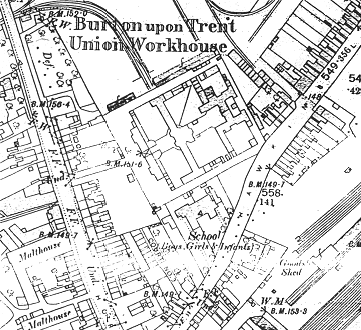
Burton original Union workhouse site, 1882.
The building appears to have followed one of Scott and Moffatt's standard designs with a single-storey entrance block at the west. This had a central archway and would have contained a porter's lodge, board-room, offices and a chapel. To the rear, the main accommodation block was three storeys high, with the Master and Matron's accommodation at the centre, with males housed to one side and females to the other. An H-shaped block to the rear is likely to have been an infirmary. Around the edge of the site were various workshops and utility rooms such as the laundry.
Following the opening of a new workhouse on Belevedere Road in 1884, the old workhouse infirmary was used as an infectious diseases hospital. The site was sold to Messrs. Bass, Ratcliff and Gretton, June 1891 for £3000. The workhouse buildings have been demolished and the site is now used for storage by a brewery.
In 1842, the Commissioners investigating the employment and conditions of children in mines and manufactories, discovered that workhouse boys, some as young as eight, were being sent on "apprenticeships" of up to twelve years working in coal mines. As a result, some unions in the coal-mining districts of South Staffordshire and adjacent areas were asked to provide detailed information on the children who had been apprenticed in the mining industry in recent years. The return for the Burton-upon-Trent covering the years 1841-42 is included below.
| Date | Name of Child | Age | Residence | Name of Master | Mine |
|---|---|---|---|---|---|
| 9 February 1841 | James Alsbrook | 12 | Union Workhouse with his mother, a widow | Joahn Oates of Darlaston, miner | New iron-stone mine, Caper's Field, Bilston, proprietor Mr Bagnall |
| 9 February 1841 | Thomas Firman | 14 | An orphan in Union Workhouse | Edward Severn, Darlaston, miner | Blue Hat iron-stone mine, Crowder's Filed, Wednesbury, proprietor Mr Crowder |
| 9 February 1841 | John Lidgbird | 11 | In Union Workhouse with mother and family, deserted by father | George Oates, Darlaston, miner | New iron-stone mine, Caper's Field, Bilston, proprietor Mr Bagnall |
| October 1841 | Thomas Vero | 14 | At Burton Extra with his mother, a widow with a large family | William Oates, Darlaston, miner | New Mine coal mine, Mellor's field, Darlaston, proprietor Mr Bromley |
| 11 January 1842 | William Durant | 12 | At Burton-upon-Trent, with his mother, a widow with large family | Joseph Butler, Darlaston, miner | Eatham coal mine, Mutton Field, near Bradley, Bilston, proprietor Mr Wilkinson |
| April 1842 | John Redfern | 13 | An orphan in Union Workhouse | ditto | ditto |
| April 1842 | George Kendrick | 12 | In Union Workhouse, deserted by his father, his mother being dead | John Mee, Wednesbury, miner | Eatham coal mine, Old Park Field, Wednesbury, proprietor Mr Lloyd |
The Burton Guardians were at pains to point out the care they employed when placing children for apprenticeship: premiums in money were not allowed and the boys were instead provided with two full suits of clothes; any master applying for a boy was required to produce a certificate of character from the minister and officers of the parish in which he resides; a trial period of at least six weeks was required, at the end of which the boy was brought before the magistrates and strictly questioned as to his food, lodging, moral and religious instruction, and especially whether he had any objection to the apprenticeship being formalised.
The Belvedere Road Workhouse
In 1880, construction began of a new larger workhouse to accommodate 550 inmates at a site to the north-west of the town on the south side of Dallow Lane (later renamed Belvedere Road) at Outwoods. It was designed by JH Morton from South Shields and built by the Messrs. Walker and Slater of Derby. It cost £43,000 to build and was formally opened on 23rd October, 1884, by Chairman of the Board of Guardians, Major Bindley. The site location and layout are shown on the 1901 map below.
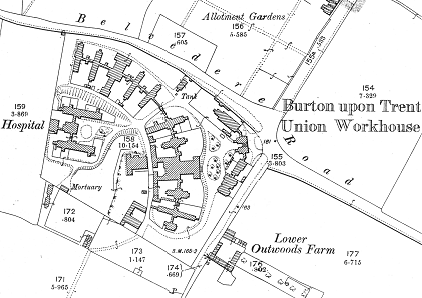
Burton-upon-Trent workhouse site, 1901.
An architect's drawing from 1886 gives a bird's eye view of the site from the east.
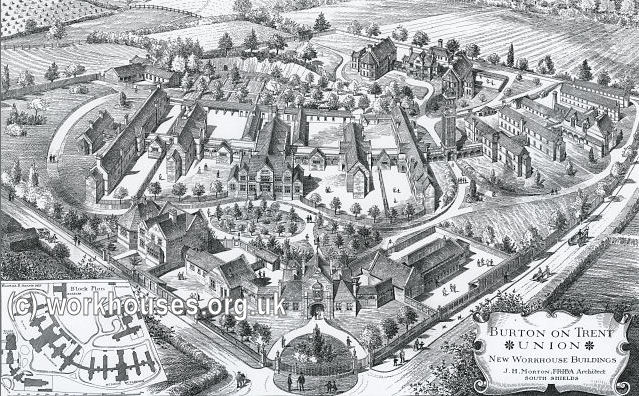
Burton-upon-Trent Belvedere Road workhouse from the east
The main sections of the building are indicated below:
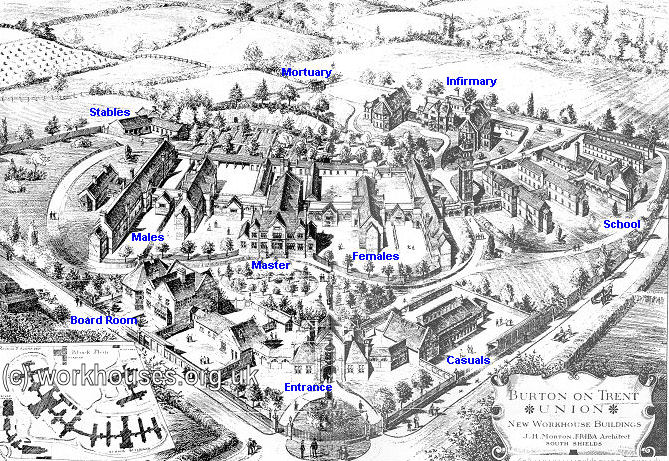
Burton-upon-Trent workhouse from the east
At the main entrance at the corner of Belvoir Road and Belvedere Road were a porter's lodge, offices and a waiting room. An archway led to reception rooms, and to tramps' cells for 38 men and 16 women. Adjacent to the single-storey entrance blocks was a two-storey block containing the Board of Guardians' offices and board-room.
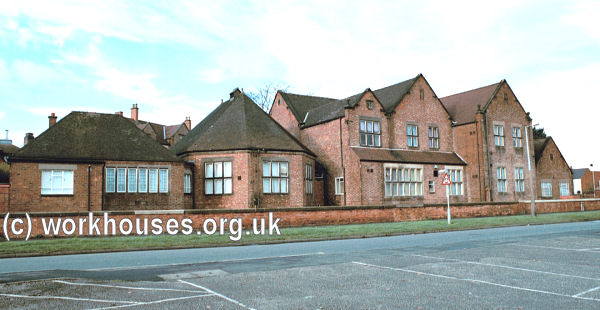
Burton-upon-Trent office and boardroom block from the south-east, 2000.
© Peter Higginbotham.
Behind the entrance blocks stood a block containing the Master's house, dining-hall and kitchens.
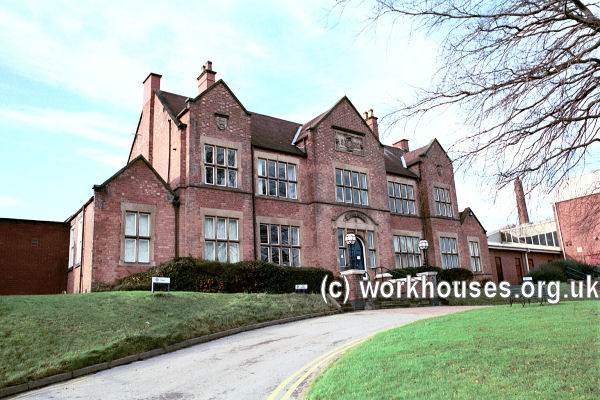
Burton Master's House from the south-east, 2000.
© Peter Higginbotham.
The main inmates' accommodation was in a series of two-storey pavilions with males at the left and females at the right. A laundry block was placed at the rear of the female side.
At the north, the site also included a school and accommodation for for 125 boys, girls and infants.
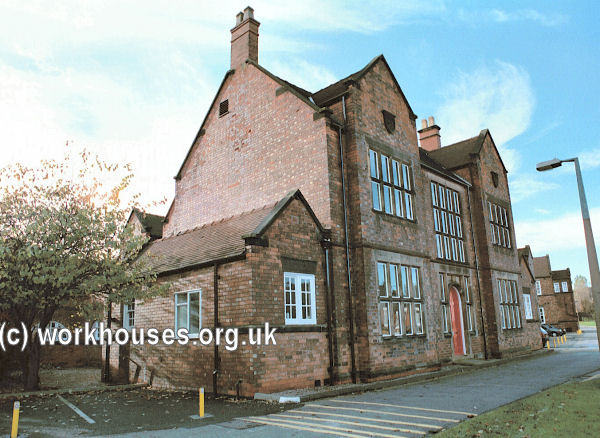
Burton-upon-Trent workhouse school from the east, 2000.
© Peter Higginbotham.
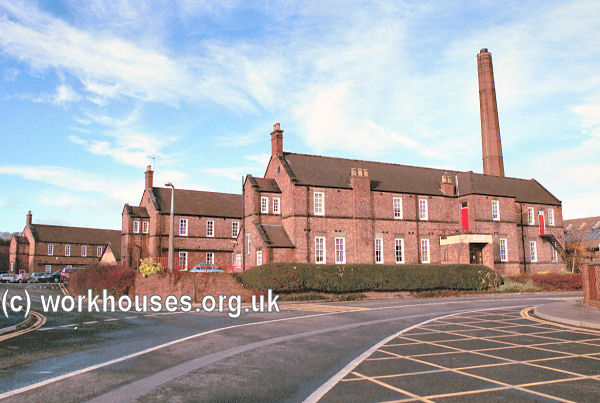
Burton-upon-Trent workhouse children's accommodation pavilions from the south, 2000.
© Peter Higginbotham.
An infirmary at the west of the site had a central administration block flanked by male and female pavilions.
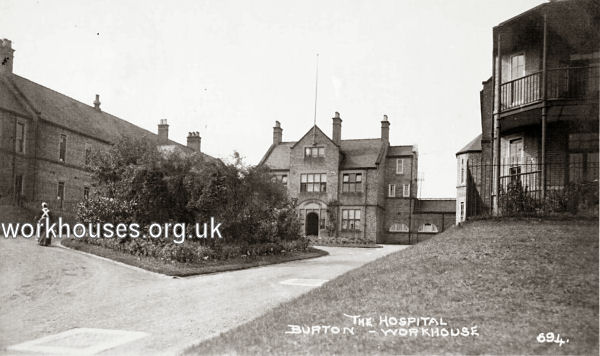
Burton-upon-Trent workhouse infirmary, early 1900s.
In 1930, the workhouse became Burton-upon-Trent Public Assistance Institution, then transferred to the NHS in 1948, after which it became Burton District Hospital. The site is now Queen's Hospital.
Girls' Home
By 1908, the Burton-upon-Trent Union had established a girls' home at 'The Ferns' on Station Road, Barton-under-Needwood. In 1924, the home could house 11 girls and the superintendent was A.S. Salt.
Staff
Inmates
Records
Note: many repositories impose a closure period of up to 100 years for records identifying individuals. Before travelling a long distance, always check that the records you want to consult will be available.
- Lichfield Record Office, The Friary, Lichfield, WS13 6QG. Holdings include: Guardians' minute books (1837-1930); Births and Deaths (1837-1879); Admissions and discharges (1880-1930); etc.
Bibliography
- Molyneux, William (1869) Burton-on-Trent: Its waters and Its Breweries.
Links
- None.
Unless otherwise indicated, this page () is copyright Peter Higginbotham. Contents may not be reproduced without permission.


